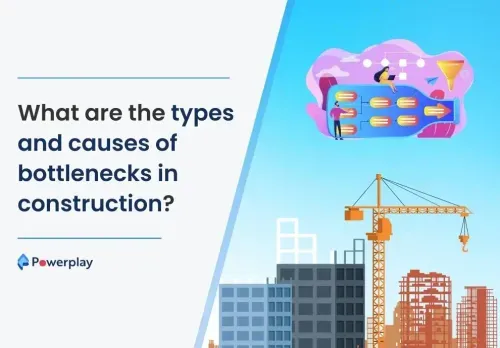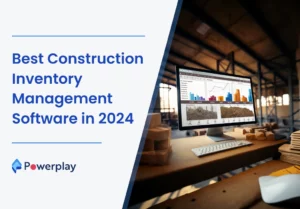What is a bottleneck in construction project management?
-
Kumar Abhishek Anand
- October 23, 2023

A bottleneck is a phase in a project that stalls or completely stops subsequent tasks and outcomes. In this phase, there is more workload than the execution process can handle. Bottlenecks cause inefficiencies which result in delays or increases in execution costs. The term “bottleneck” compares such situations to the narrowest parts of a bottle. A bottle’s neck slows the flow of a process due to congestion in one or more activities.
Companies have a higher risk of experiencing a bottleneck when constructing a new structure or during the execution process due to flaws that may come up. Bottleneck situations can either be short-term or long-term. A short-term bottleneck is a temporary situation and rarely results in any significant effects. Long-term bottlenecks occur for long durations and they slow down execution significantly.
Table of Contents
ToggleTypes of bottlenecks
It is important to understand the types of bottlenecks to analyze, diagnose and manage such situations accurately. Additional problems can arise if you incorrectly identify an issue as a bottleneck. There are two main types of bottlenecks in project management:
1. System-based bottlenecks
System-based bottlenecks occur due to slow, old or obsolete machineries or equipment. They may also be caused by infrastructure, software, applications and inefficient systems. It is important to review your project logs to identify system-based bottlenecks carefully.
2. Performer-based bottleneck
A performer-based bottleneck arises when an individual or a team within a project provides a limited performance. It doesn’t necessarily mean that your team members are not working hard enough—this could occur due to too much demand on a team member or the entire group. It can be a sign to increase the workforce because it’s stretched too thin. Performance-based bottlenecks also occur because of some understandable circumstances, like a team member taking sick leave.
Here is how to identify a bottleneck in 3 steps:
1. Visualize – Keeping track of your work makes it very easy to see where work items pile up, which is a strong sign of a problem, most likely a bottleneck.
2. Map Queues and Activities – When we separate queues and activities and map them, we can see how much time a certain activity has prior to a the next activity in queue. If you compare the speed with which the queue is growing with the actual pace of project progress, you can determine the bottleneck.
3. Measure Cycle Time per Stage – Measuring cycle time at every stage lets you build a cycle time heat map diagram. Just a glance at this diagram reveals the stages where cards spend the most time. If these workflow stages are queues, too, those are probably your bottlenecks.
What are the effects of a bottleneck in construction project management?
Bottlenecks in project management affect the workflow and the progress of a project. They also cause other effects like backlogged work, long wait times, reduced efficiency, loss of revenue, dissatisfied clients, waste of productive time, high stress levels, reduced team morale, etc.
What are the main causes of bottleneck in project management?
Bottlenecks arise because of various reasons, some of which may include:
1. Single-sourcing
Single-sourcing is where a project or business relies heavily on one supplier. It increases the risks of bottlenecks because if the supplier has any issues, it affects your operations. For example, if the supplier has delivery delays, your project operation can slow down and come to a halt. The best solution to avoid single-sourcing bottlenecks is to get multiple suppliers. It also helps to have backup inventory in case of delays.
2. Poor technology integration
Poor technology integration and infrastructure can also lead to bottlenecks. There is poor technology integration when a supplier lacks the technology to match your needs appropriately. For example, they may lack the right information technology infrastructure, leading to unexpected lead time increases. Your company’s lack of technology infrastructure can also cause bottlenecks because the execution process will slow down or stop.
3. Lack of planning
Lack of proper planning can cause bottlenecks due to unexpected issues. For example, planning silos causes bottlenecks. This happens when various groups or departments in a project plan their operations independently. It is important to avoid planning silos and bottlenecks coordinate with the related units to avoid any unwanted disruptions.
4. Low visibility
Low visibility occurs when you don’t have the full insight into all of the project’s details, including the raw materials, inventory and process. Lack of planning and proper monitoring can lead to low visibility in your project. The project manager needs to carry out a thorough assessment and communicate well with the various teams and individuals to avoid low visibility bottlenecks.
5. Teamwork challenges and collaboration issues
There may be various barriers and challenges that hinder teamwork. Some team members may not fully embrace their duties, lack the skills the team needs, have poor team management and have unclear duties. It is important to eliminate all challenges and barriers to teamwork to avoid bottlenecks.
Collaboration has some similarities to teamwork, but they are quite different. In teamwork, individuals work together, but you also have to think together with collaborations. Collaborations occur when members from different departments in an organization come together to stitch each of their units’ ideas into a single, fluid picture. All the members in collaboration are equal partners and their collective efforts directly help create the end product.
All the above mentioned bottlenecks can be easily overcome using the Powerplay app. With Powerplay, you can efficiently plan your project on our platform and get better visibility over the entire project progress. Collaboration and communication within the project team becomes much easier with the chat feature provided on the software.
Share
Kumar is a digital content professional with more than 2 years of experience in Blog writing, copywriting and scripting. His passion lies in the art of creating convincing content that plays a major role in converting leads for SAAS businesses.












